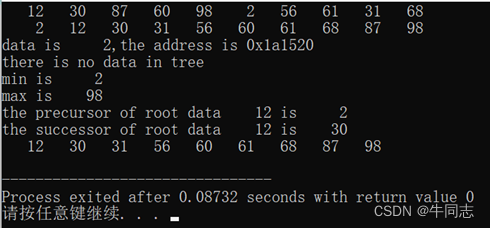文章目录
前言
本文主要讲解了二叉搜索树,并且用C语言是实现了它的所有基本操作函数,给出了C语言代码
一、二叉搜索树
1.什么是二叉搜索树?
二叉搜索树是一颗二叉树,它是链表存储结构,同时满足特定的数据性质(见下)
顾名思义,二叉搜索树有很好的搜索性能,有诸多应用
它的操作函数有:
1.中序遍历(输出有序数据序列)
2.返回最大最小值
3.搜索值
4.返回某个结点的左右顺序统计量
5.插入,删除结点
2.二叉搜索树有什么优势?
(1)应用
1.作为字典存储数据,提供插入,删除,搜索功能
2.输出排好序的序列
3.作为优先队列
4.等等
(2)时间性能
一般情况下,它的所有操作函数的时间代价都是:
T
(
n
)
=
O
(
h
)
=
O
(
l
g
n
)
其中
h
为期望树高
,
h
=
O
(
l
g
n
)
T(n)=O(h)=O(lgn) \\其中h为期望树高,h=O(lgn)
T(n)=O(h)=O(lgn)其中h为期望树高,h=O(lgn)
3.二叉搜索树的数据特点
设x是二叉搜索树中的一个结点。如果y是x左子树中的一个结点,那么 y . k e y ? x . k e y y.key\leqslant x.key y.key?x.key。如果y是x右子树中的一个结点,那么 y . k e y ? x . k e y y.key\geqslant x.key y.key?x.key。
它本质上是维护一个局部的有序。这个局部的有序有点类似于堆。
(1)二叉搜索树与堆的数据性质的区别
1.二叉搜索树是将所有小于等于的结点放到左子树,所有大于等于的结点放到右子树
2.堆是在维护一个局部最值,即双亲结点永远要大于(最小堆是小于)孩子结点
具体可以参考文章:
《算法导论》学习(七)----堆排序和优先队列(C语言)
二、二叉搜索树的操作函数(C语言)
1.数据结构
数据结构包涵三个部分:
1.存储key值
2.指向左孩子结点的指针
3.指向有孩子结点的指针
4.指向父亲结点的指针
//定义二叉搜索树的结构
typedef struct STree
{
int key;//结点的值
STree *p;//指向双亲结点
STree *left;//指向左孩子结点
STree *right;//指向有孩子结点
}ST;
2.中序遍历二叉搜索树
中序遍历的规则:
1.从横向来看:先遍历左子树,再遍历本结点,再遍历右子树
2.从竖向来看:先右下的叶子节点,再向上到根结点,再到坐下的叶子结点
二叉搜索树通过中序遍历,其结果是一个从小到大的有序数列。
(1)中序遍历
//中序遍历二叉搜索树
void inorder_tree_walk(ST *x)
{
//由于二叉搜索树的特点
//使用中序遍历的结果是从大到小的有序排列
if(x!=NULL)
{
//先遍历左子树
inorder_tree_walk(x->left);
//遍历本结点
printf("%5d",x->key);
//遍历右子树
inorder_tree_walk(x->right);
}
else
{
return;
}
}
(2)打印遍历结果
//打印二叉搜索树
void print_tree(ST *x)
{
inorder_tree_walk(x);
printf("\n");
}
3.查找数据
查找到该结点,就返回它的地址信息。
没有查到就返回NULL
(1)查找数据函数
//在二叉搜索树中查找数据
ST *tree_search(ST *x,int k)
{
//循环结束条件就是
//1.结点指针为空
//2.结点指针指向k结点
while(x!=NULL&&x->key!=k)
{
//如果k小于本结点,那么向左子树搜索
if(k<x->key)
{
x=x->left;
}
//如果k大于等于本结点,那么向右子树搜索
else
{
x=x->right;
}
}
return x;
}
(2)打印查找信息
//打印查找信息
void print_search(ST *x)
{
if(x==NULL)
{
printf("there is no data in tree\n");
}
else
{
printf("data is %5d,the address is 0x%x\n",x->key,x);
}
}
4.得到最大值
返回最大值的地址
根据二叉搜索树的性质,最大值是最右最下的叶子结点
//得到最大值
ST *tree_max(ST *x)
{
//最右最下的那个叶子结点就是最大值
while(x->right!=NULL)
{
x=x->right;
}
return x;
}
5.得到最小值
返回最小值的地址
根据二叉搜索树的性质,最小值是最左最下的叶子结点
//得到最小值
ST *tree_min(ST *x)
{
//最左最下的那个叶子结点就是最小值
while(x->left!=NULL)
{
x=x->left;
}
return x;
}
6.找到后继结点
后继结点的定义:
后继结点就是所有大于该结点的树节点中最小的那个
//得到指定结点x的后继结点
//后继结点就是所有大于该结点树节点中最小的那个
ST *tree_successor(ST *x)
{
//如果该结点有右子树,那么后继就是右子树的最小值
if(x->right!=NULL)
{
return tree_min(x->right);
}
ST *y=x->p;
//如果没有右子树,那么后继结点就是该结点的一个上层结点
//而且该结点一定是这个上层结点的左子树中的结点
//那么后继就是第一个满足条件的祖先结点
while(y!=NULL&&x==y->right)
{
x=y;
y=y->p;
}
return x;
}
7.找到前驱结点
前驱结点的定义:
前驱结点就是所有小于该结点的树节点中最大的那个
//得到指定结点x的前驱结点
//前驱结点就是所有小于该结点树节点中最大的那个
ST *tree_precursor(ST *x)
{
//如果该结点有左子树,那么前驱就是左子树的最大值
if(x->left!=NULL)
{
return tree_max(x->left);
}
ST *y=x->p;
//如果没有左子树,那么前驱结点就是该结点的一个上层结点
//而且该结点一定是这个上层结点的右子树中的结点
//那么前驱就是第一个满足条件的祖先结点
while(y!=NULL&&x==y->left)
{
x=y;
y=y->p;
}
return x;
}
8.插入元素到树
//给树中插入函数
ST *tree_insert(ST *x,int k)
{
ST *y=NULL;
ST *head=x;
//如果是空结点,那么直接连接
if(x==NULL)
{
//动态分配空间
y=(ST *)malloc(sizeof(ST));
y->key=k;
y->left=NULL;
y->p=NULL;
y->right=NULL;
x=y;
return x;
}
//如果树不为空
//那么按照搜索树的规则,找到要插入对象的位置
//该位置是一个叶子结点
while(x!=NULL)
{
y=x;
if(x->key>k)
{
x=x->left;
}
else
{
x=x->right;
}
}
//分配空间
x=(ST *)malloc(sizeof(ST));
x->key=k;
x->p=y;
x->left=NULL;
x->right=NULL;
if(y->key>k)
{
y->left=x;
}
else
{
y->right=x;
}
return head;
}
9.将一个子树替换为另外一个子树
该函数是为删除函数做准备的,删除函数需要大量调用
在删除函数中,它的功能是将u结点从树中分割出来,并且将以v结点为根结点的子树替换u结点的位置
//将一颗子树替换为另一颗子树
//u是被替换子树根结点
//v是替换子树根结点
void ctree_change(ST *x,ST *u,ST *v)
{
if(x==u)
{
x=v;
}
else if(u==u->p->left)
{
u->p->left=v;
}
else
{
u->p->right=v;
}
if(v!=NULL)
{
v->p=u->p;
}
}
10.删除结点
//删除一个结点
void tree_delet(ST *x,int k)
{
ST *k_p;
k_p=tree_search(x,k);
if(k_p==NULL)
{
printf("there is no k in tree\n");
}
else
{
//如果没有左子树
//那么直接用右子树替换该子树
if(k_p->left==NULL)
{
ctree_change(x,k_p,k_p->right);
free(k_p);
}
//如果没有右子树
//那么直接用左子树替换该子树
else if(k_p->right==NULL)
{
ctree_change(x,k_p,k_p->left);
free(k_p);
}
else
{
ST *temp=NULL;
//找到后继结点
temp=tree_min(k_p->right);
if(temp->p!=k_p)
{
//将后继结点提取出来
ctree_change(x,temp,temp->right);
//将后继结点与被删除结点的右子树相连
temp->right=k_p->right;
temp->right->p=temp;
}
//提取被删除结点
ctree_change(x,k_p,temp);
//将后继结点与被删除结点的左子树连接
temp->left=k_p->left;
temp->left->p=temp;
free(k_p);
}
}
}
三、二叉搜索树的C语言例子
1.实际执行结果

2.C语言代码
#include<stdio.h>
#include<stdlib.h>
#include<time.h>
//输入的规模
#define SIZE 10
//随机数的范围是0~LIM-1
#define LIM 100
//定义二叉搜索树的结构
typedef struct STree
{
int key;//结点的值
STree *p;//指向双亲结点
STree *left;//指向左孩子结点
STree *right;//指向有孩子结点
}ST;
//中序遍历二叉搜索树
void inorder_tree_walk(ST *x)
{
//由于二叉搜索树的特点
//使用中序遍历的结果是从大到小的有序排列
if(x!=NULL)
{
//先遍历左子树
inorder_tree_walk(x->left);
//遍历本结点
printf("%5d",x->key);
//遍历右子树
inorder_tree_walk(x->right);
}
else
{
return;
}
}
//打印二叉搜索树
void print_tree(ST *x)
{
inorder_tree_walk(x);
printf("\n");
}
//在二叉搜索树中查找数据
ST *tree_search(ST *x,int k)
{
//循环结束条件就是
//1.结点指针为空
//2.结点指针指向k结点
while(x!=NULL&&x->key!=k)
{
//如果k小于本结点,那么向左子树搜索
if(k<x->key)
{
x=x->left;
}
//如果k大于等于本结点,那么向右子树搜索
else
{
x=x->right;
}
}
return x;
}
//打印查找信息
void print_search(ST *x)
{
if(x==NULL)
{
printf("there is no data in tree\n");
}
else
{
printf("data is %5d,the address is 0x%x\n",x->key,x);
}
}
//得到最大值
ST *tree_max(ST *x)
{
//最右最下的那个叶子结点就是最大值
while(x->right!=NULL)
{
x=x->right;
}
return x;
}
//得到最小值
ST *tree_min(ST *x)
{
//最左最下的那个叶子结点就是最小值
while(x->left!=NULL)
{
x=x->left;
}
return x;
}
//得到指定结点x的后继结点
//后继结点就是所有大于该结点树节点中最小的那个
ST *tree_successor(ST *x)
{
//如果该结点有右子树,那么后继就是右子树的最小值
if(x->right!=NULL)
{
return tree_min(x->right);
}
ST *y=x->p;
//如果没有右子树,那么后继结点就是该结点的一个上层结点
//而且该结点一定是这个上层结点的左子树中的结点
//那么后继就是第一个满足条件的祖先结点
while(y!=NULL&&x==y->right)
{
x=y;
y=y->p;
}
return x;
}
//得到指定结点x的前驱结点
//前驱结点就是所有小于该结点树节点中最大的那个
ST *tree_precursor(ST *x)
{
//如果该结点有左子树,那么前驱就是左子树的最大值
if(x->left!=NULL)
{
return tree_max(x->left);
}
ST *y=x->p;
//如果没有左子树,那么前驱结点就是该结点的一个上层结点
//而且该结点一定是这个上层结点的右子树中的结点
//那么前驱就是第一个满足条件的祖先结点
while(y!=NULL&&x==y->left)
{
x=y;
y=y->p;
}
return x;
}
//给树中插入函数
ST *tree_insert(ST *x,int k)
{
ST *y=NULL;
ST *head=x;
//如果是空结点,那么直接连接
if(x==NULL)
{
//动态分配空间
y=(ST *)malloc(sizeof(ST));
y->key=k;
y->left=NULL;
y->p=NULL;
y->right=NULL;
x=y;
return x;
}
//如果树不为空
//那么按照搜索树的规则,找到要插入对象的位置
//该位置是一个叶子结点
while(x!=NULL)
{
y=x;
if(x->key>k)
{
x=x->left;
}
else
{
x=x->right;
}
}
//分配空间
x=(ST *)malloc(sizeof(ST));
x->key=k;
x->p=y;
x->left=NULL;
x->right=NULL;
if(y->key>k)
{
y->left=x;
}
else
{
y->right=x;
}
return head;
}
//将一颗子树替换为另一颗子树
void ctree_change(ST *x,ST *u,ST *v)
{
if(x==u)
{
x=v;
}
else if(u==u->p->left)
{
u->p->left=v;
}
else
{
u->p->right=v;
}
if(v!=NULL)
{
v->p=u->p;
}
}
//删除一个结点
void tree_delet(ST *x,int k)
{
ST *k_p;
k_p=tree_search(x,k);
if(k_p==NULL)
{
printf("there is no k in tree\n");
}
else
{
//如果没有左子树
//那么直接用右子树替换该子树
if(k_p->left==NULL)
{
ctree_change(x,k_p,k_p->right);
free(k_p);
}
//如果没有右子树
//那么直接用左子树替换该子树
else if(k_p->right==NULL)
{
ctree_change(x,k_p,k_p->left);
free(k_p);
}
else
{
ST *temp=NULL;
//找到后继结点
temp=tree_min(k_p->right);
if(temp->p!=k_p)
{
//将后继结点提取出来
ctree_change(x,temp,temp->right);
//将后继结点与被删除结点的右子树相连
temp->right=k_p->right;
temp->right->p=temp;
}
//提取被删除结点
ctree_change(x,k_p,temp);
//将后继结点与被删除结点的左子树连接
temp->left=k_p->left;
temp->left->p=temp;
free(k_p);
}
}
}
//主测试函数
int main()
{
ST *t=NULL;//搜索二叉树
ST *temp;//中间存储结点
int a[SIZE];
int i=0;
//生成原始随机数据
srand((unsigned)time(NULL));
for(i=0;i<SIZE;i++)
{
a[i]=rand()%LIM;
}
//打印原始数据
for(i=0;i<SIZE;i++)
{
printf("%5d",a[i]);
}
printf("\n");
//生成搜索二叉树
for(i=0;i<SIZE;i++)
{
t=tree_insert(t,a[i]);
}
//用中序遍历打印生成的搜索二叉树
//结果是排好序的,从小到大
print_tree(t);
//查找值
//存在的值
temp=tree_search(t,a[5]);
print_search(temp);
//不存在的值
temp=tree_search(t,LIM);
print_search(temp);
//返回最大值,最小值
//最小值
temp=tree_min(t);
printf("min is %5d\n",temp->key);
//最大值
temp=tree_max(t);
printf("max is %5d\n",temp->key);
//返回前驱值和后继
//前驱值
temp=tree_precursor(t);
printf("the precursor of root data %5d is %5d\n",t->key,temp->key);
//后继值
temp=tree_successor(t);
printf("the successor of root data %5d is %5d\n",t->key,temp->key);
//删除值
tree_delet(t,a[5]);
print_tree(t);
return 0;
}
总结
本文的不妥之处请读者包涵指正